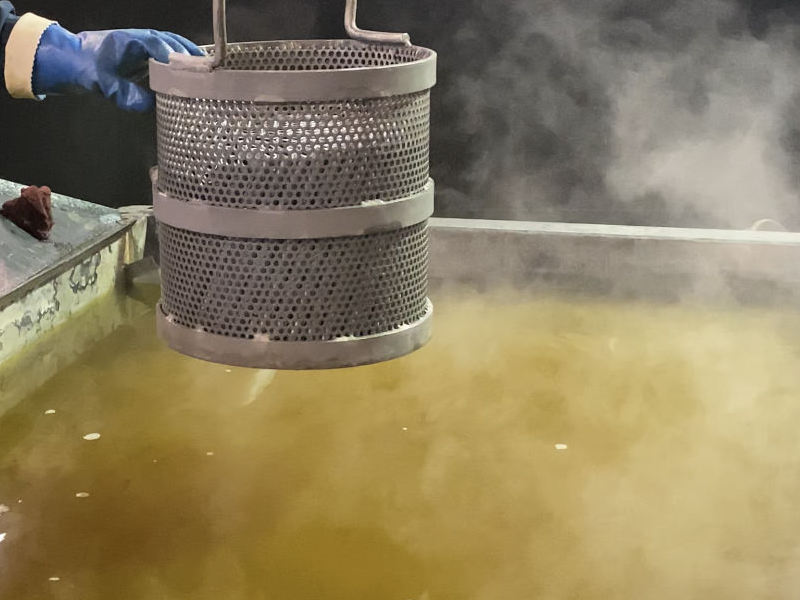A substantial category of metal finishing processes is — to varying degrees —temperature-dependent.
 Stephen F. Rudy CEFThere is typically an operating temperature range that permits quality surface treatment to be achieved, in line with maintenance of other complimentary conditions. Some of these processes offer limited freeboard for temperatures.
Stephen F. Rudy CEFThere is typically an operating temperature range that permits quality surface treatment to be achieved, in line with maintenance of other complimentary conditions. Some of these processes offer limited freeboard for temperatures.
Examples include cleaners, bright dips, chemical polishes, plating baths, electroless nickel, phosphates, chromates, and oxidized treatments, to name a few. Conversely, we acknowledge processes that do require heating but offer a wider range of operating temperatures. Are we taking the best economical advantage of the required temperature in accordance with satisfactory surface treatment? The question may become more pronounced in that higher energy consumption may significantly raise the cost of a step in the cycle. This, in turn, may affect job quotes and, ultimately, profit margins. In a tight economy wrapped around related problems we are all aware of, any process improvements can result in savings of operation.
One important parameter that requires no ads or dilutions is temperature. Let us, for example, consider heated soak and electro cleaners. I will provide examples in which the reader can plug in current costs to help determine if any temperature changes may be viable and cost-effective alternatives.
The cleaner tank presently operates at 175°F (79°C). The plant manager is advised by the supplier that an effective temperature range for the cleaner at recommended concentration is 140°F to 185°F (60°C to 85°C). Some bench testing was done to confirm that per the cleaning requirements within the residence time, operating the cleaner at 150°F (66°C) would not only be adequate but indeed satisfactory.
Related calculations, shown in the block below, were then completed to determine just what effect lowering the temperature of the cleaner would have with regard to energy expense or savings.
- The cleaner tank dimensions in feet are 5 × 4 × 4 (deep).
- The area of the tank wall is: (5 × 4) × 2 + (4 × 4) × 2 = 40 + 32 = 72 ft2.
- From an energy consumption chart, the loss at 175°F = 240 BTU/hr, the loss at 150°F = 175 BTU/hr
- By subtraction, the savings are 65 BTU/hr × 72 ft2= 4,680 BTU/hr; the area of the surface of the tank in feet is: 5 × 4 = 20 ft2
- From an energy consumption chart, the loss at 175°F = 1,800 BTU/hr the loss at 150°F = 950 BTU/hr
- By subtraction, the savings are 850 BTU/hr × 20 ft2= 17,000 BTU/hr adding both energy savings gives a total energy savings of 21,680 BTU/hr.
At this point, plug in the acknowledged cost for the heating source per hour. This could be steam, oil, gas, or electric. The dollar savings by reducing the cleaner operating temperature by 25°F can then be obtained.
This exercise can be a worthwhile project whereby realistic costs related to heating a tank can be achieved.
Additionally, do not overlook the importance of tank insulation. Over the years, the quality of insulation has dramatically improved. R factors for heat savings offer a wide range of insulation wraps for a wide variety of industrial applications. It is noted that up to two inches of the recommended insulation material can reduce heat radiation losses by over 90%. Even if the above cleaner temperature reduction is not appropriate, nothing should stand in the way of smart outer tank insulation. If the cleaner tank temperature can be reduced, then insulation is an added saving in heating cost reduction.
Other savings associated with heating include preferred temperature control. This can be achieved by the use of pre-set thermostats or covering a tank when not in use. Consulting with the supplier may also provide appropriate lower temperature cleaners, combination soak and electro cleaner eliminating one process tank, or perhaps off-line cleaning by a mass finishing step, as viable examples.
As we all know quite well, energy in whatever form is not cheap. There are many factors affecting our industry. Unfortunately, related prices and costs have risen sharply. Whatever we can do to offset these can certainly help the bottom line. Does the cleaner tank have to be that hot?
Stephen F. Rudy, CEF, is president of Chem Analytic LLC and has written extensively about the finishing industry. Visit www.chemanalytic.com or call him at 917-604-5001.



































